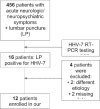Human Herpes Virus 7-related encephalopathy in children
- PMID: 35441609
- PMCID: PMC9179060
- DOI: 10.23750/abm.v92iS4.12664
Human Herpes Virus 7-related encephalopathy in children
Abstract
Background: Primary HHV7 infection is almost ubiquitous, and it can present as exanthema subitem. Little is known on the clinical relevance of HHV7 neuroinvasion in immunocompetent children.
Methods: We describe 12 patients (median age 9.45 years, 50% males) with acute encephalopathy and active HHV7 infection. In all patients, HHV7-DNA was detected on cerebrospinal fluid (CSF) by RT-PCR.
Results: 7/12 patients had meningoencephalitis (two with ADEM and one with MOG antibody-associated CIS); 5/12 showed acute neuropsychiatric symptoms. EEG showed anomalies exclusively in patients with meningoencephalitis. Six patients had RMN anomalies. CSF HHV7 copies ranged between 20 and 3,500 copies/mL (median 66 copies/mL) and mean HHV7 CSF/blood ratio was 0.75. Outcome was favorable in all children, although 3/12 had minor neurobehavioral sequelae. Mean follow-up period of 5.2 months.
Conclusions: HHV7 can determine neuroinvasion in immunocompetent children, leading to acute encephalopathy. Blood-brain barrier damage and high CSF/blood viral copies ratio correlated with a more severe presentation. We speculate on the importance of immune-mediated mechanisms in provoking clinical features.
Conflict of interest statement
Each author declares that he or she has no commercial associations (e.g. consultancies, stock ownership, equity interest, patent/licensing arrangement etc.) that might pose a conflict of interest in connection with the submitted article
Figures
Similar articles
-
Asymmetric periflexural exanthema associated with HHV7 infection.Eur J Dermatol. 2010 Mar-Apr;20(2):230-1. doi: 10.1684/ejd.2010.0854. Epub 2009 Nov 17. Eur J Dermatol. 2010. PMID: 19919914 No abstract available.
-
Congenital infections with human herpesvirus 6 (HHV6) and human herpesvirus 7 (HHV7).J Pediatr. 2004 Oct;145(4):472-7. doi: 10.1016/j.jpeds.2004.06.017. J Pediatr. 2004. PMID: 15480369
-
Human Herpesvirus 7-Related Acute Encephalopathy with Biphasic Seizures and Late Reduced Diffusion.Pediatr Infect Dis J. 2020 Feb;39(2):170-172. doi: 10.1097/INF.0000000000002557. Pediatr Infect Dis J. 2020. PMID: 31929436
-
Acute myelitis by human herpes virus 7 in an HIV-infected patient.J Clin Virol. 2016 Apr;77:63-5. doi: 10.1016/j.jcv.2016.02.001. Epub 2016 Feb 11. J Clin Virol. 2016. PMID: 26906233 Review.
-
Case report and literature review: HHV-6-associated meningoencephalitis in an immunocompetent adult.Herpes. 2008 Nov;15(2):33-5. Herpes. 2008. PMID: 19856546 Review.
Cited by
-
Encephalitis in the Course of HHV-7 Infection in an Infant.J Clin Med. 2024 Jan 12;13(2):418. doi: 10.3390/jcm13020418. J Clin Med. 2024. PMID: 38256552 Free PMC article.
-
Update on human herpesvirus 7 pathogenesis and clinical aspects as a roadmap for future research.J Virol. 2024 Jun 13;98(6):e0043724. doi: 10.1128/jvi.00437-24. Epub 2024 May 8. J Virol. 2024. PMID: 38717112 Free PMC article. Review.
-
Correlation between viral infections in male semen and infertility: a literature review.Virol J. 2024 Jul 30;21(1):167. doi: 10.1186/s12985-024-02431-w. Virol J. 2024. PMID: 39080728 Free PMC article. Review.
-
Severe Human Herpesvirus 7 Infection in Healthy Children.Fukushima J Med Sci. 2025 Jul 3;71(3):187-194. doi: 10.5387/fms.24-00010. Epub 2025 Mar 6. Fukushima J Med Sci. 2025. PMID: 40058811 Free PMC article.
-
Human herpes virus-7-related severe encephalitis diagnosed using mNGS in immunocompetent pediatric patients.Virol J. 2025 Aug 21;22(1):287. doi: 10.1186/s12985-025-02841-4. Virol J. 2025. PMID: 40842029 Review.
References
-
- Kenneth J. Ryane. Sherris medical microbiology : an introduction to infectious diseases: Third edition. Norwalk, Conn. : Appleton & Lange. [1994] ©1994; 1994.
-
- Ward KN. The natural history and laboratory diagnosis of human herpesviruses-6 and -7 infections in the immunocompetent. J Clin Virol. 2005;32(3):183–193. - PubMed
-
- Huang LM, Lee CY, Liu MY, Lee PI. Primary infections of human herpesvirus-7 and herpesvirus-6: a comparative, longitudinal study up to 6 years of age. Acta Paediatr. 1997;86(6):604–608. - PubMed
MeSH terms
LinkOut - more resources
Full Text Sources
Medical



